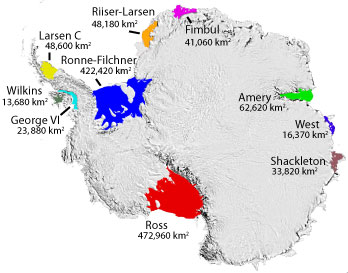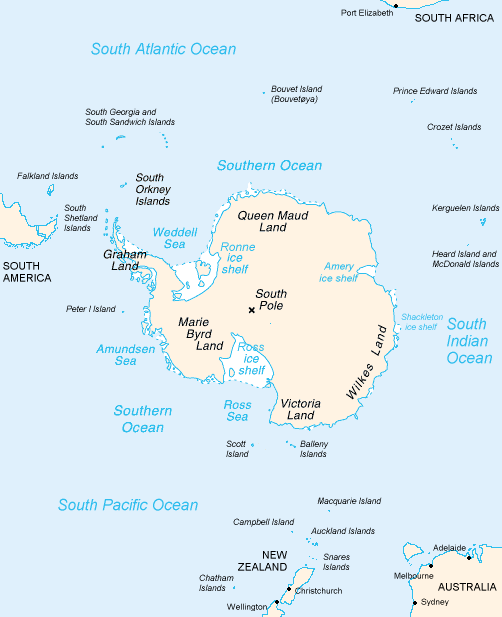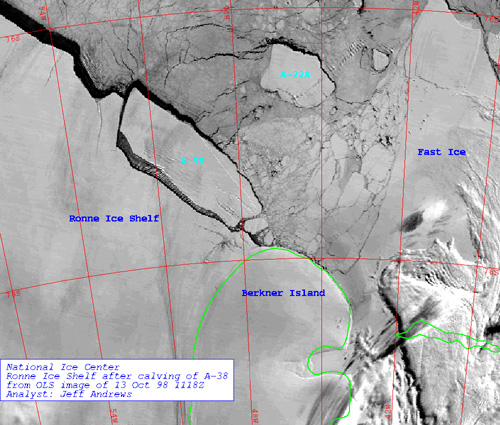Filchner–Ronne Ice Shelf on:
[Wikipedia]
[Google]
[Amazon]





 The Filchner-Ronne Ice Shelf, also known as Ronne-Filchner Ice Shelf, is an Antarctic ice shelf bordering the
The Filchner-Ronne Ice Shelf, also known as Ronne-Filchner Ice Shelf, is an Antarctic ice shelf bordering the
/ref> In May 2021,6.2.1. Filchner-Ronne Ice Shelf Programme
. WAIS: The
A study published in ''
Big Antarctic ice sheet appears doomed; Warming climate predicted to trigger collapse of Filchner-Ronne shelf by 2100
June 2, 2012; Vol.181 #11 (p. 5)




 The Filchner-Ronne Ice Shelf, also known as Ronne-Filchner Ice Shelf, is an Antarctic ice shelf bordering the
The Filchner-Ronne Ice Shelf, also known as Ronne-Filchner Ice Shelf, is an Antarctic ice shelf bordering the Weddell Sea
The Weddell Sea is part of the Southern Ocean and contains the Weddell Gyre. Its land boundaries are defined by the bay formed from the coasts of Coats Land and the Antarctic Peninsula. The easternmost point is Cape Norvegia at Princess Mar ...
.
Description
The seaward side of the Filchner-Ronneice shelf
An ice shelf is a large floating platform of ice that forms where a glacier or ice sheet flows down to a coastline and onto the ocean surface. Ice shelves are only found in Antarctica, Greenland, Northern Canada, and the Russian Arctic. Th ...
is divided into Eastern (Filchner) and the larger Western (Ronne) sections by Berkner Island
Berkner Island (also known as the Berkner Ice Rise or as Hubley Island) is an Antarctic ice rise, where bedrock below sea level has caused the surrounding ice sheet to create a dome. If the ice cap were removed, the island would be underwater. B ...
. The whole ice shelf covers some 430,000 km2, making it the second largest ice shelf in Antarctica (and on Earth), after the Ross Ice Shelf
The Ross Ice Shelf is the largest ice shelf of Antarctica (, an area of roughly and about across: about the size of France). It is several hundred metres thick. The nearly vertical ice front to the open sea is more than long, and between h ...
. It grows perpetually due to a flow of inland ice sheets. From time to time, when the shearing stresses exceed the strength of the ice, cracks form and large parts of the ice sheet separate from the ice shelf and float off and disperse as iceberg
An iceberg is a piece of freshwater ice more than 15 m long that has broken off a glacier or an ice shelf and is floating freely in open (salt) water. Smaller chunks of floating glacially-derived ice are called "growlers" or "bergy bits". Th ...
s. This is known as calving.
The Ronne ice shelf is the larger and western part of the Filchner-Ronne ice shelf. It is bounded on the west by the base of the Antarctic Peninsula
The Antarctic Peninsula, known as O'Higgins Land in Chile and Tierra de San Martín in Argentina, and originally as Graham Land in the United Kingdom and the Palmer Peninsula in the United States, is the northernmost part of mainland Antarctic ...
(Graham Land
Graham Land is the portion of the Antarctic Peninsula that lies north of a line joining Cape Jeremy and Cape Agassiz. This description of Graham Land is consistent with the 1964 agreement between the British Antarctic Place-names Committee a ...
with Zumberge Coast Zumberge Coast is that portion of the southeast coast of Palmer Land between Cape Zumberge and the south entrance point to Hercules Inlet. Overlooking the west part of Ronne Ice Shelf, this coast was mapped by United States Geological Survey
...
and Orville Coast Orville Coast is that portion of the coast of Antarctica lying west of Ronne Ice Shelf between Cape Adams and Cape Zumberge. It was discovered by the Ronne Antarctic Research Expedition (RARE), 1947–48, under Ronne, who named this coast for Capt ...
) and Ellsworth Land
Ellsworth Land is a portion of the Antarctic continent bounded on the west by Marie Byrd Land, on the north by Bellingshausen Sea, on the northeast by the base of Antarctic Peninsula, and on the east by the western margin of the Filchner–Ronn ...
. Commander Finn Ronne
Finn Ronne (December 20, 1899 – January 12, 1980) was a Norwegian-born U.S. citizen and Antarctic explorer.
Background
Finn Ronne was born in Horten, in Vestfold county, Norway. His father, Martin Rønne (1861–1932), was a polar explorer ...
, USNR, leader of the Ronne Antarctic Research Expedition
The Ronne Antarctic Research Expedition (RARE) was an expedition from 1947–1948 which researched the area surrounding the head of the Weddell Sea in Antarctica.
Background
Finn Ronne led the RARE which was the final privately sponsored ex ...
(RARE) in 1947–48, discovered and photographed a strip along the entire northern portion of this ice shelf in two aircraft flights in November and December 1947. He named it the "Lassiter Shelf Ice" and gave the name "Edith Ronne Land" to the land presumed to lie south of it. In 1957–58, the US- IGY party at Ellsworth Station
Ellsworth Scientific Station ( es, Estación Científica Ellsworth, or simply ''Estación Ellsworth'' or ''Base Ellsworth'') was a permanent, all year-round originally American, then Argentine Antarctic scientific research station named after Ame ...
, under now Captain Ronne, determined that the ice shelf was larger than previously charted, that it extends southward to preempt most of "Edith Ronne Land
Edith Ronne Land was the unofficial name of that portion of Antarctica which is bordered by Palmer Land and Ellsworth Land to the West, Coats Land to the East, and the Filchner-Ronne Ice Shelf to the North. In December 2012, this region was offici ...
". Inasmuch as Capt. James Lassiter's name has been assigned to a coast of Palmer Land
Palmer Land () is the portion of the Antarctic Peninsula, Antarctica that lies south of a line joining Cape Jeremy and Cape Agassiz. This application of Palmer Land is consistent with the 1964 agreement between the Advisory Committee on Antarctic ...
, the Advisory Committee on Antarctic Names
The Advisory Committee on Antarctic Names (ACAN or US-ACAN) is an advisory committee of the United States Board on Geographic Names responsible for recommending commemorative names for features in Antarctica.
History
The committee was established ...
(US-ACAN) approved the name Ronne Ice Shelf for this large ice shelf, on the basis of first sighting and exploration of the ice shelf by Ronne and parties under his leadership. The shelf is therefore named for Edith Ronne
Jackie Ronne (October 13, 1919 – June 14, 2009) was an American explorer of Antarctica and the first woman in the world to be a working member of an Antarctic expedition (1947–48). She is also the namesake of the Ronne Ice Shelf.
Biography ...
, the wife of Finn Ronne and RARE Expedition member.
The Filchner ice shelf is the eastern part of the Filchner-Ronne ice shelf. It is bounded on the west by Berkner Island and on the east by Coats Land
Coats Land is a region in Antarctica which lies westward of Queen Maud Land and forms the eastern shore of the Weddell Sea, extending in a general northeast–southwest direction between 20°00′W and 36°00′W. The northeast part was disco ...
. The east part of this shelf was discovered in January–February 1912 by the German Antarctic Expedition under Wilhelm Filchner
Wilhelm Filchner (13 September 1877 – 7 May 1957) was a German army officer, scientist and explorer. He conducted several surveys and scientific investigations in China, Tibet and surrounding regions, and led the Second German Antarctic Expediti ...
. Filchner named the feature for Kaiser Wilhelm Kaiser Wilhelm is a common reference to two German emperors:
* Wilhelm I, German Emperor (1797–1888)
* Wilhelm II, German Emperor (1859–1941)
Kaiser Wilhelm may also refer to:
* Kaiser Wilhelm (baseball) (1874–1936), early 20th century bas ...
, but the Emperor requested it be named for its discoverer. The shelf is nourished primarily by the Slessor Glacier
The Slessor Glacier is a glacier at least 140 km (75 nmi) long and 90 km (50 nmi) wide, flowing west into the Filchner Ice Shelf to the north of the Shackleton Range. First seen from the air and mapped by the Commonwealth Trans-Antarct ...
, the Recovery Glacier
The Recovery Glacier () is a glacier flowing west along the southern side of the Shackleton Range in Antarctica. First seen from the air and examined from the ground by the Commonwealth Trans-Antarctic Expedition in 1957, it was so named because ...
, and the Support Force Glacier
Support Force Glacier is a major glacier in the Pensacola Mountains, draining northward between the Forrestal Range and Argentina Range to the Filchner-Ronne Ice Shelf. Mapped by the United States Geological Survey from surveys and US Navy air p ...
, all located east of Berkner Island.
In 2021, sponges
Sponges, the members of the phylum Porifera (; meaning 'pore bearer'), are a basal animal clade as a sister of the diploblasts. They are multicellular organisms that have bodies full of pores and channels allowing water to circulate throug ...
and other unidentified suspension feeders were reported to have been found growing on a boulder under the western margin of the Filchner ice shelf, close to Berkner Island, at a depth of 1,233 m (872 of which were ice), 260 km from open water.
Calving
In October 1998, theiceberg A-38
A-38 was a large iceberg that split from the Filchner-Ronne Ice Shelf in Antarctica in October 1998. Soon after formation it split into two pieces, A-38A and A-38B, which drifted westwards on the Weddell Gyre. The icebergs moved north along ...
broke off the Filchner-Ronne ice shelf. It had an extent of roughly 150 by 50 km and was thus larger than Delaware
Delaware ( ) is a state in the Mid-Atlantic region of the United States, bordering Maryland to its south and west; Pennsylvania to its north; and New Jersey and the Atlantic Ocean to its east. The state takes its name from the adjacen ...
. It later broke up again into three parts. A similar-sized calving in May 2000 created an iceberg 167 by 32 km in extent, dubbed A-43 – the disintegration of this is thought to have been responsible for the November 2006 sighting of several large icebergs from the coast of the South Island
The South Island, also officially named , is the larger of the two major islands of New Zealand in surface area, the other being the smaller but more populous North Island. It is bordered to the north by Cook Strait, to the west by the Tasma ...
of New Zealand
New Zealand ( mi, Aotearoa ) is an island country in the southwestern Pacific Ocean. It consists of two main landmasses—the North Island () and the South Island ()—and over 700 List of islands of New Zealand, smaller islands. It is the ...
, the first time since 1931 that any icebergs had been observed from the New Zealand mainland. A large group of small icebergs (the largest some 1000 metres in length), were seen off the south-east coast of the island, with one of them drifting close enough to shore to be visible from the hills above the city of Dunedin
Dunedin ( ; mi, Ōtepoti) is the second-largest city in the South Island of New Zealand (after Christchurch), and the principal city of the Otago region. Its name comes from , the Scottish Gaelic name for Edinburgh, the capital of Scotland. Th ...
. If these were indeed the remnants of this calving, then over the course of five and a half years they had travelled slowly north and also east around over half the globe, a journey of some 13,500 km.NIWA reportNational Institute of Water and Atmospheric Research
The National Institute of Water and Atmospheric Research or NIWA ( mi, Taihoro Nukurangi), is a Crown Research Institute of New Zealand. Established in 1992, NIWA conducts research across a broad range of disciplines in the environmental scienc ...
From January 12 and January 13, 2010, an area of sea ice larger than the state of Rhode Island
Rhode Island (, like ''road'') is a state in the New England region of the Northeastern United States. It is the smallest U.S. state by area and the seventh-least populous, with slightly fewer than 1.1 million residents as of 2020, but i ...
, or one-seventh the size of Wales
Wales ( cy, Cymru ) is a Countries of the United Kingdom, country that is part of the United Kingdom. It is bordered by England to the Wales–England border, east, the Irish Sea to the north and west, the Celtic Sea to the south west and the ...
, broke away from the Ronne-Filchner Ice Shelf and shattered into many smaller pieces. The Moderate-Resolution Imaging Spectroradiometer
The Moderate Resolution Imaging Spectroradiometer (MODIS) is a satellite-based sensor used for earth and climate measurements. There are two MODIS sensors in Earth orbit: one on board the Terra ( EOS AM) satellite, launched by NASA in ...
(MODIS) on NASA's Aqua
Aqua is the Latin word for water. It is used in many words which relate to water, such as aquatic life. In English, it may also refer to:
Arts
* Aqua (color), a greenish-blue color
Business
* Aqua (skyscraper), an 82-story residential skysc ...
and Terra
Terra may often refer to:
* Terra (mythology), primeval Roman goddess
* An alternate name for planet Earth, as well as the Latin name for the planet
Terra may also refer to: Geography Astronomy
* Terra (satellite), a multi-national NASA scienti ...
satellites captured this event in this series of photo-like images.Rapid Sea Ice Breakup along the Ronne-Filchner Ice Shelf/ref> In May 2021,
Iceberg A-76
An iceberg is a piece of freshwater ice more than 15 m long that has broken off a glacier or an ice shelf and is floating freely in open (salt) water. Smaller chunks of floating glacially-derived ice are called "growlers" or "bergy bits". The ...
broke off the northwest corner of the shelf. At 4320 km2, it is larger than Majorca
Mallorca, or Majorca, is the largest island in the Balearic Islands, which are part of Spain and located in the Mediterranean.
The capital of the island, Palma, is also the capital of the autonomous community of the Balearic Islands. The Bale ...
, several times larger than Iceberg A-74
Iceberg A-74 is an iceberg that calved from the north side of the Antarctic Brunt Ice Shelf in February 2021. Its calving had been anticipated due to large ice rifts that opened up in September 2019 and spread in the Antarctic summer of 2020– ...
which calved in the same year, or approximately 14% the size of Belgium
Belgium, ; french: Belgique ; german: Belgien officially the Kingdom of Belgium, is a country in Northwestern Europe. The country is bordered by the Netherlands to the north, Germany to the east, Luxembourg to the southeast, France to ...
.
The ice of the Filchner-Ronne ice shelf can be as thick as 600 m; the water below is about 1400 m deep at the deepest point.
The international Filchner-Ronne Ice Shelf Programme (FRISP) was initiated in 1973 to study the ice shelf.. WAIS: The
West Antarctic Ice Sheet
The Western Antarctic Ice Sheet (WAIS) is the segment of the continental ice sheet that covers West Antarctica, the portion of Antarctica on the side of the Transantarctic Mountains that lies in the Western Hemisphere. The WAIS is classified as a ...
Initiative.Nature
Nature, in the broadest sense, is the physical world or universe. "Nature" can refer to the phenomena of the physical world, and also to life in general. The study of nature is a large, if not the only, part of science. Although humans ar ...
'' in 2012 by scientists from the Alfred Wegener Institute for Polar and Marine Research
The Alfred Wegener Institute, Helmholtz Centre for Polar and Marine Research (German: ''Alfred-Wegener-Institut, Helmholtz-Zentrum für Polar- und Meeresforschung'') is located in Bremerhaven, Germany, and a member of the Helmholtz Association o ...
in Germany, and funded by the Ice2Sea
Ice2sea was a program of scientific research funded by the European Union'to study the effects of climate change on glaciation and the melting of ice caps and glaciers on sea level. The ice2sea project, a collaborative of 24 research institutions, ...
initiative, predicts the disappearance of the vast ice shelf in Antarctica by the end of the century which could – indirectly – add up to of rise of sea level each year.
See also
*Belgrano I Base
Belgrano I Base ( es, Base Belgrano I) was a permanent, all year-round Argentine Antarctic base and scientific research station, located on Piedrabuena Bay on the Filchner Ice Shelf. It was named after General Manuel Belgrano, one of the Liber ...
*Ellsworth Station
Ellsworth Scientific Station ( es, Estación Científica Ellsworth, or simply ''Estación Ellsworth'' or ''Base Ellsworth'') was a permanent, all year-round originally American, then Argentine Antarctic scientific research station named after Ame ...
* Filchner Trough
* Grand Chasms
*Weddell Gyre
The Weddell Gyre is one of the two gyres that exist within the Southern Ocean. The gyre is formed by interactions between the Antarctic Circumpolar Current (ACC) and the Antarctic Continental Shelf. The gyre is located in the Weddell Sea, and ro ...
References
External links
* *Big Antarctic ice sheet appears doomed; Warming climate predicted to trigger collapse of Filchner-Ronne shelf by 2100
June 2, 2012; Vol.181 #11 (p. 5)
Science News
''Science News (SN)'' is an American bi-weekly magazine devoted to articles about new scientific and technical developments, typically gleaned from recent scientific and technical journals.
History
''Science News'' has been published since ...
.
{{DEFAULTSORT:Filchner-Ronne Ice Shelf
British Antarctic Territory
Ice shelves of Antarctica
Argentine Antarctica
Chilean Antarctic Territory
*
Bodies of ice of Queen Elizabeth Land